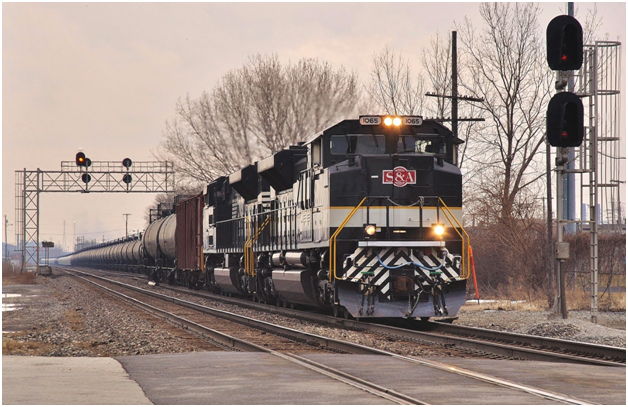
Bright new LED signal aspects like that shown in the center left may overpower or obscure older, dimmer traditional incandescent signal aspects like those shown at upper right, the NTSB said in a new Safety Alert which cautions railroads to take steps to avoid this circumstance. A westbound Norfolk Southern crude oil train led by the Savannah & Atlanta heritage unit passes both types of signals at Whiting Indiana on NS’s New York to Chicago main line in March 2013. © 3/2013 Paul Burgess, used with permission.
The United States National Transportation Safety Board (NTSB) has issued a Safety Alert to railroads operating in the United States which cautions them about potential confusion or other risks associated with the presence of both LED and incandescent bulb type signal aspects placed adjacent to one another at rail junctions. Railroads are in the process of replacing incandescent bulb illuminated signal aspects with those illuminated with LED’s, which are not only brighter, but consume far less electrical power and have much longer operational life expectancies than incandescent bulbs. This helps the railroad lower maintenance and operating costs. However, with many thousands of older incandescent signals still in service nationwide, the process is expected to take many years.
In an analysis of the collision and subsequent wreck of two trains on the Union Pacific Railroad near Galva, Kansas in September of 2014, the NTSB has found that a train crew’s inability to see a red “stop” indication ahead of them was due to the nearby presence of another and much newer LED illuminated signal displaying a green “proceed” signal. The Board found that the new LED driven signal was intrinsically much brighter than the older incandescent signal’s illumination of a “stop” indication, and it visually overwhelmed the older signal’s display. In the accident, a collision occurred as one train entered a siding to allow another train to pass. The older type incandescent signal correctly displayed a stop aspect for the approaching train. However the approaching train’s crew did not see the stop indication for the reason the NTSB noted above, and instead could only see the next and very nearby LED driven new signal, which was displaying a green “proceed” indication. As a result, the approaching train was not stopped and instead collided with the train entering the siding. Fortunately, although damage to the two trains was significant, no injuries were incurred nor were nearby communities affected.
The NTSB makes several recommendations in the Safety Alert to help mitigate the risk of recurrence, and these are presented verbatim below:
- Identify locations where the close spacing of signals may cause a signal to either mask or visually dominate another signal—especially at locations where LED and incandescent light units have been installed in close proximity.
- Evaluate the railroad computer aided dispatching (CAD) software to prevent stacked requests from lining routes non-sequentially at multiple control points—particularly at locations where signals are located near one another.
- In addition to performing all mandatory operational tests on signals, railroads should conduct a hazard analysis that includes testing signal visibility (conspicuity test) with input from train crews.
- Configuration management is critical in evaluating the safety of proposed changes to railroad systems, including signals and train control, motive power, rail cars, methods of operation, and track. Implement procedures to notify all personnel of changes they may encounter.
The Safety Alert also outlines the steps that the Union Pacific Railroad took in the immediate aftermath of the accident, to address the problem prior to NTSB intervention. This included modernizing the signals at the site of the accident and making certain operational changes to their dispatching procedures regarding signal control in an effort to minimize the risk of such an accident happening again.
The full Safety Alert may be found here:
http://www.ntsb.gov/safety/safety-alerts/Documents/SA_038.pdf
Labelmaster is a full service provider of goods and services for the Hazardous Materials and Dangerous Goods professional, shippers, transport operators, and EH&S providers. See our full line of solutions at www.labelmaster.com.